There is a theory of “primitive affluence” that suggests that when a society has its primary needs met by Nature…food, shelter, clothing…then it will turn to creativity. Bali, a tropical island in Indonesia where the rich volcanic soil produces an abundance of food and materials for fabrics and building, is held as an example. The trope is that “everyone in Bali is an artist.” Yet, while it is true that most everyone spends days carving, painting and dancing, there is very little originality in the products…all are variations on a standard theme, precisely ritualistic, all expressed within rigid boundaries. The island’s most famous dance, Kecak, was created by a German painter and musician, in the 1930s, intended as a performance for tourists.
On the other side of the field, Malcolm Gladwell, the counter-intuitive craftsman, in his book “David and Goliath: Underdogs, Misfits, and the Art of Battling Giants,” promotes the idea of “desirable difficulty,” wherein disadvantages propel people to extraordinary achievement and creativity.
Northern Ireland may be the poster child for Mr. Gladwell’s theory. About the size of Connecticut, with less than half the population (about 2 million people), it has a wildly disproportionate number of fearless creatives and original thinkers. Yes, it is as far from “primitive affluence” as can be found. The land has few natural resources. Everything from coal to timber to iron has to be imported. For much of the year, the weather is cold and dank. And, for years, the region endured ethno-nationalist and sectarian strife. One rumor has it that when archeologists broke into King Tut’s tomb they found a newspaper with the headline, “Irish Problems Still Unsolved.”
The exceedingly carbonated era that began in 1969, known as The Troubles, ended with the Good Friday Agreement of April 10th, 1998, an accord that brought the Peace Dividend, a surge in cathexis with the land, and the beginnings of a surprising renaissance.
Yet, throughout its fractious history Northern Ireland has continued to unleash unreasonable creativity. The Kelvin scale was invented by a Belfastian; the ejection seat, portable defibrillator, modern tractor, the safety lamp for miners and chocolate milk by engineers from County Down. It could be argued distilled whiskey was concocted here, as the flush toilet.
On the entrepreneurial side, Northern Ireland, despite its challenges, became the largest linen producer in the world. And had the largest ropeworks. It was the largest manufacturer of fizzy drinks; largest shirt maker; had the largest flax machine works; largest tobacco factory; largest handkerchief factory in the world. For a time, a century ago, it was the world’s leading industrial city, anchored by the biggest shipyard in the world, and there it created the biggest man-made moving object in history…the ocean liner Titanic.
And then the arts. This matrix of Anglo-Catholic alchemy spawned such as John Butler Yeats, C.S. Lewis, Jack Higgins (who was raised here), Oscar Wilde (who schooled in County Fermanagh), Sir Kenneth Branagh, Patrick Magee, Sam Neill, Liam Neeson, and the most famous film star of the land, The DeLorean. There is not so much sun in this northern clip of the world, so folks are often inside sipping the hot cup of creativity, fanning the flames of magic turf.
When I read, then, that one of my teenage heroes, Van Morrison, was being awarded “The Freeman of Belfast” honor (which allows him to drive his herd of sheep through the center of town), I knew I had to go and jump into this place.
So well I remember standing on the sidelines at a high-school mixer, too shy to cross the room and make the ask. But when Gloria, performed by Them (named for the 1954 horror movie about giant radioactive ants) with the deep burr of Van Morrison’s voice slashing through paper walls, came on the record player, I found a beat and a gift of confidence I never knew I had, and strutted across the floor and asked the most beautiful girl to dance. And she said yes.
I won’t commit the crime of cliché and say his songs were the soundtrack of my life, but there were milestones marked in the Druidic forest trails of his music. Moondance, for instance, enabled my own passage to freemanhood, and I’m sure I am not alone in that refrain.
With the first bite of fall I make the pilgrimage to Northern Ireland, to Belfast, where Van Morrison, after a life-time of travel, and living in the artistic meccas of Woodstock and Marin County, has come home, to the place he was born.
I make my way to Waterfront Hall, and settle in just below Violet Morrison, Van’s mom, in the balcony. It’s a family affair, as the chief back-up singer is Van’s daughter, Shana.
Silence, anticipation seem in command. Then The Lord Mayor Máirtín Ó Muilleoir takes the mic, and says “He united us in the past, he’s united us tonight and he will unite us in the future. This honor represents our love, respect and gratitude for Van Morrison from the ‘dark side of the street to the bright side of the road’.”
And Van the Freeman, six-time Grammy-winner, sporting signature dark suit, black hat and sunglasses, struts out stage left and gives a thumbs up to the crowd. He signs a special scroll, accepts a gold key to the city, bows, and then, without a word, picks up his alto sax, and launches into a sensual Celtic Swing. And from there into Moondance, Brown Eyed Girl, and a roll call of greats, many citing patches of his personal map, sign posts and street names from his East Belfast boyhood. Van, of course, remains rock’s foremost curmudgeon, and true to form he lets the music do the talking, rarely speaking, sometimes turning his back to the audience to play.
But at 68, after 50 years as a fiercely prolific artist, he still summons the nerve to sing about the world as if it remains to be made, or as if it could be unmade, something he’s witnessed in his hometown. As so many in Northern Ireland, he rattles the door of convention in its frame. And as he growls his lines, making himself into a sea monster, his daughter Shana swoops over him and digs into the songs, adding fervor in a glittering dress.
Just before Into the Mystic, The Belfast Cowboy sits down and jests: “This is the part where I hide behind the piano.” A German journalist next to me, who has been to a score of Van’s concerts, turns to me shocked and says “that’s the most he’s ever said at a concert.” Then the piano takes off, like a boat untied, into waves of melody. There is the feeling that Van is looking back at his dock from a future already passed.
This is a “hand of history” moment in Belfast. We’re immersed in something called “yarragh,”—fleeting elusive moments of transcendence, when the sense of an unrepeatable event is present. Like the city itself, this is an irresolvable adventure, someplace between the breaks and holes in the music.
He ends the municipal tribute with a muscle and fiber rendition of “Gloria,” and I am transported back, as no doubt many in the audience, to teendom, to that moment when we loosed ourselves from words and floated on the bowers of his music.
Van is now a Freeman of Belfast, which is doubly significant, as just a few years ago men were not free to walk this city, and now they are.
The day after the concert I head out to meet another cyclone-in-residence, Terri Hooley, the “godfather of punk,” at the latest awakening of his record shop, Good Vibrations, with its 1955 Elvis effigy out-front. He is still, after all these years, hawking vinyl, posters, and the trending whiffs of the 70s. He insists we head over to the pub for a pint of Guinness with a brandy chaser, his preferred poison for the last half century. He lost an eye with a stray arrow as a boy, and has a reputation for plucking out his glass eye and dropping it into a drink, so I keep my pint out of reach. After a sip or few he shares, “I honestly believe punk bands saved countless lives, keeping impressionable young people away from the paramilitaries and giving us all something exciting to focus on.”
Terri Hooley first opened his record shop on Great Victoria Street in 1976, at the time the most bombed piece of real estate in the world. It quickly became a safe haven, a neutral harbor, at a time when things were very thin on the ground. Teens and lost tribes from all sections and classes, from both sides of the divide, joined by a love of music, hung out in peace, preferring tunes to stones, music and culture more than the dead hand of sectarianism. It was a firefly of light in the blackness of Belfast at the time.
Though a Hank Williams fan in a polo neck, when he heard Punk it screeched his being. “To be a punk was to be different from the past.” He started his own label, and produced edgy, alternative records. “Teenage Kicks,” by the Undertones, was his biggest hit. He took the record to London and pedaled it around, but no one bit. “They said it was the worst record they ever heard in their lives.” Then John Peel, the rock-star DJ, played it on the BBC, twice, in a row, and the Undertones were signed to a major label. Hooley never did it for the money…his store has gone bankrupt more times than the airlines…and he still doesn’t have any savings, but his unending efforts to build peace through music are recognized now around the world. “My brother was addicted to heroin; I’m addicted to having a record shop.”
“For such a small population we have more talent per head of poets, painters and performers than anywhere else in Europe. Because of our in-between status the arts give young people something to be proud of. It proves to every kid here that he can achieve something, and have a bloody good laugh doing it.”
Terri has a sign in his store at the top of the stairs, “Help the Aged Appeal. Don’t let the elderly be on their own. Support this lonely old man by coming to hear him play his golden oldies every Thursday night at the Voodoo.” I ask Terri if he still pogoes, and his eyes light up (well, his eye actually), and with a quick smile, up and down he bunts, like a kid on caffeine.
I make my way back to the Europa, once the most shelled hotel in the world, now a chic boutique. Along the way I pass the Albert Clock, which lists like the leaning tower of Pisa. It not only has the inclination, it has the time.
And I take a stop at the storied Ulster Hall, the Grand Dame of Bedford Street, where if the walls could talk, they wouldn’t talk, they would sing. Glenn Miller performed for American Troops stationed in Belfast preparing for the Normandy invasion of 1944 (a local saw at the time: The Americans are “oversexed, overpaid and over here; the Brits are undersexed, underpaid, and under Eisenhower); Paul Robeson bellowed Old Man River here. The Rolling Stones, in 1964, played their shortest set, 13 minutes, before hysterical fans broke up the show. Led Zeppelin debuted Stairway to Heaven here in 1971 to an unimpressed audience. The Clash were due to play in 1977, but when insurance was cancelled for the gig, hundreds of disappointed fans rioted. Terri Hooley said it may have been “the only riot of the Troubles where Catholics and Protestants were fighting on the same side.”
That evening its back to Waterfront Hall, this time for a concert celebrating the man who threw a net across the world with his poetry, Seamus Heaney, the Nobel Prize-winner who died in August 2013 at 74. His final message to the world, written in Latin just minutes before he passed: ‘Noli timere’, “Don’t be afraid.”
The main presenter is Belfast-born actor Stephen Rea (were you surprised in The Crying Game?), who enjoyed a 35-year relationship with Seamus. They both served as directors of the Field Day Theatre company, which they saw as a “direct intervention” of art and culture during The Troubles.
Mr. Rea takes the first lines flatly, simply, as though he has too much respect for the words to add theatre. He seems to know that any phrase he renders is guaranteed to perfume the room, and so keeps the oil light.
But as the evening progresses Mr. Rea becomes bolder, pressing the words like bricks, then flies over verses towards some unreachable shore of release. When he lights on certain sounds, certain small moments inside a poem—hesitations, silences, shifts in pressure, sudden entrances, slamming doors—they suggest whole territories, completed stories, indistinct ceremonies, far outside anything that can be literally traced into the compositions that carry them.
It is, in the end, an evening made of fragments, alternating between the textures and cadence of Seamus Heaney’s words, and music that seems to have floated up between his lines. There is in his poetry a kind of quest, and from the moment his words are voiced everything is transformed. There are moments when I feel a realm beyond ordinary expression, reaching out as if to close my hand around it, but then I would open my fist, to find… a butterfly within.
The next day, into the crisp morning air, pointillistic with mist, I head out on a guided tour of Heaney Country in County Derry.
Seamus Heaney Country. Photo by Laura Hubber
My guide, Ken McElroy, is a poet unjustly unsung, with a voice that takes up more room in the car than seems legal. He also teaches me the difference between prose and poetry with an example:
“Two brothers named Pollocks
Who were both alcoholics
They went for swim
The tide came in
And the water rose to their…knees.
Another 12 inches and it would have been poetry.”
Ken drives, retracing Seamus’s schoolboy footsteps along Lagan’s Road, where he walked his first date with wife-to-be, Marie. We roll by the blacksmith’s shop at the Hillhead, the inspiration for the poem The Forge, and as I draw a breath I know I am breathing Heaney history, along with the air, and smoke. We wade into a marsh with an overlook to a steeple that looks beckoning, like a bent finger. It is Church Island, about which he wrote the eponymous ode:
“Where you weren’t known and far from what you knew:
The lowland clays and waters of Lough Beg,
Church Island’s spire, its soft treeline of yew.”
We visit next The Turfman Statue in Bellaghy. The eternal seems to be riding the back of this bronze life-size representation of his most famous poem, Digging, from Death of a Naturalist. The word “poem” seems much too small, considering it was written when 27-years-old, with lines that distinguished his life from his farmer father, and forecast his own future:
“Between my finger and my thumb The squat pen rests.
I’ll dig with it.”
Ken clearly relishes untangling the places that inspired the local laureate. Almost as pretext he explains, “Though he became internationally regarded, and held chairs at both Oxford and Harvard, he never really forgot his roots. He always identified with this small part of Ireland where he grew up.”
We make our last stop at Bellaghy’s cemetery. Seamus wanted to be buried in his own clay, in a family plot here. It takes a time to find it. Tucked away it is, in a quiet corner, festooned with one yellow bouquet of flowers taped with an anonymous note, “Thank you for the poetry.” Just to the side is a white and black sign with an arrow pointing his way, “Car Park.” He would have liked that.
Photo by Laura Hubber
Sometimes when a landscape broods music heard faintly on the edge of sound, others beyond notice, and seek their own muse in that place.
And so such it seems when the leaders of the free world chose the Lough Erne Resort, in Enniskillen for the 2013 G8 Summit. Such a gathering in Northern Ireland would have been inconceivable during The Troubles, but now the place has the draw of peace and bonny fairways, as well as identical lodges so none of the leaders could be jealous over the size or amenities of their peers.
I make my way to the castle-like resort, set on its own 600-acre peninsula, and a sign that instructs, “Ssshh….Bats Sleeping.”
After checking into the Old-World style room, I pass through the Thai Spa (if anything, Northern Ireland relishes appositions) and stop in the Blaney Bar. I sidle up to the rail across from a flickering beech log fire and order up one of the 101 Irish whiskies on the shelf, “on the rocks.” But the barkeep refuses. “You can’t order whiskey with ice here,” he scolds. “Remember the Titanic,” and he slides over a straight-up glass, leaving me to drown in my error.
Later I catch up with John O’Naill, a manager at the property, and ask about the summit.
“It was a dream event for us. Strangely enough, the golf course proved to be a suitable place for everyone to land by helicopter, so at one stage there were 22 helicopters on the 9th hole, lined up side by side. President Obama said he brought the shoes, but nobody had brought his clubs, so he couldn’t play golf. But he did walk the first four holes of the course.” I take a tool around the course in a golf cart, and it is, I can affirm, a fairway to heaven.
It is in this conducive environment that the world leaders tackled tax evasion, transparency, trade, the Syrian civil war, ending payments for kidnap victim releases, and something else of import…let me think… finding a cure for dementia by 2025.
Photo by Laura Hubber
At the Catalina Restaurant that night, over a heavenly loin of Fermangh lamb with Dauphinoise potatoes, that would fell lesser men, I try to sort out this place, Northern Ireland, and why it is such a seed-bed of creativity and enterprise. There are, it seems, natural, limbic connections that reach back to the basement of time. It’s the earned distance of this place, floating in the upper latitudinal reaches, where all the winds of the world pass.
But the strategic positioning of its capital as a port also plays a role. With the comings and goings to far-flung lands, an outward-looking ethic is a natural byproduct, an ability to assimilate and re-purpose the ideas of the world. The passing ships were in a way like bees pollinating flowers in a garden far from where they started, bringing different music, dance, foods, customs, crafts, beliefs, politics and new human constructs….and leaving behind the recipes for creativity and ingenuity. Van Morrison’s shipyard-worker dad is an example. He brought home stacks of 78s and LP records from across the oceans—blues, ballads, gospel, skiffle, folk songs, protest songs, work songs, cowboy tunes, Ray Charles (with whom Van later collaborated)— and Van soaked them up, mixed and fused them in his mind, and from them began to form his own inimitable sound.
The ports of this land allow a heightened awareness of the rest of the world, an ability to witness, often firsthand, what is working and what is not on the global stage, and to behold the interconnectedness of all things. It allows Northern Irelanders a visionary perspective—to be able to skate to where the puck is going, not to where it’s been.
And then there is the weather. When there is constant comfort, such as in the tropic zones, there is, some theorize, little incentive to boldness, little inducement for the rage to master. Imaginations turn to ice.
Yet here, the cold, the damp, the rain, they have conspired to ignite a creative “big bang” in Northern Ireland.
Finally, there are the intangibles of social, religious and political dynamics that generate virtuous circles of cutting-edge novelty, a culture of competitiveness, and aspirations. Folks here have learned to do more with less, and exceptionally so.
These, perhaps, are the “desirable difficulties,” the advantages of disadvantages, the elements that provoke imagination and resourcefulness, inventive ways around rough hands that might be dealt. These have collaborated to vault Northern Ireland to a place of high originality; and a place to visit to steep in the beauty, music, architecture, and poetry of its natural and man-made creations, and to be, quite plausibly, so inspired. There are Ulsterior motives here, as well. The winds make us lean towards this place, to inhale its spirit, and the broken waters summon us to baptize our dreams, and, in our own foreign way, contribute to the exquisite idea that is Northern Ireland.
The author and Jasper Bangs wandering Northern Ireland. Photo by Laura Hubber.
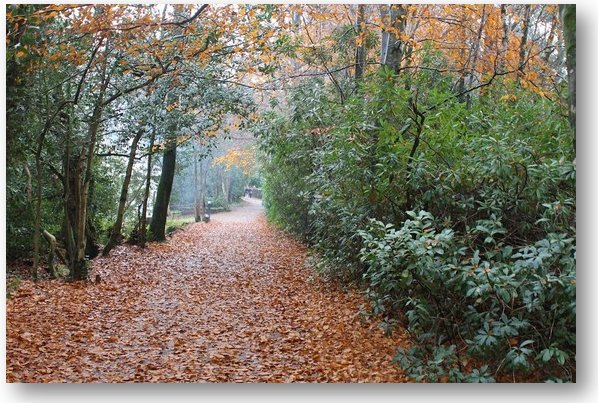
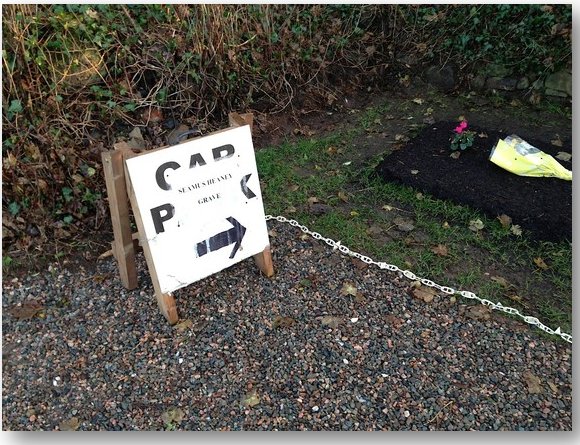
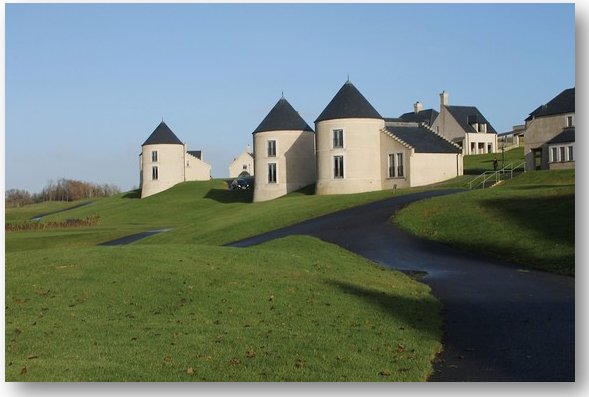
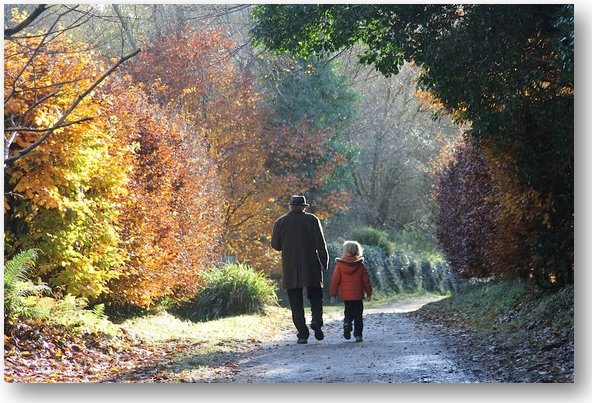
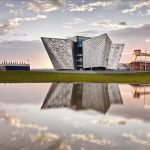

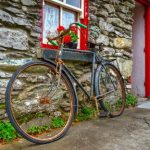
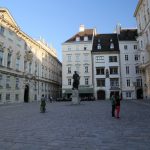

Leave a Reply